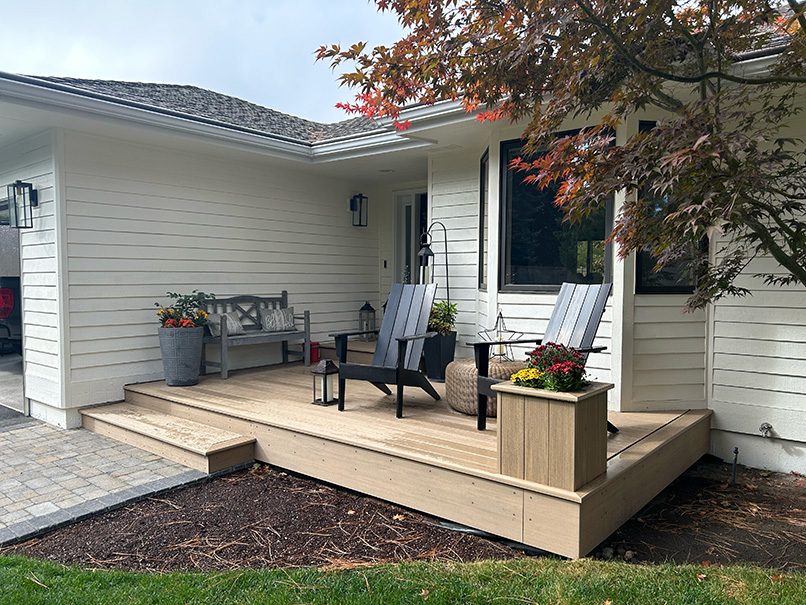
Ground-Level Deck Building Considerations
Thinking of adding a new deck to your outdoor space? You might wonder, “Can I build a deck directly on the ground?” The answer is yes, you can build a ground-level deck, but there are some important factors to consider. At Pacific Northwest Decks, we specialize in building custom decks that meet local regulations, ensuring safety, durability, and long-term satisfaction. This guide will walk you through the essentials, from selecting the right materials to understanding local codes, so you can create a functional and beautiful ground-level deck.
Key Takeaways
- Yes, you can build a deck directly on the ground, but it requires proper planning.
- You’ll need to use materials suitable for ground contact, like pressure-treated lumber or composite decking.
- Ground preparation is key to preventing moisture damage and ensuring a stable foundation.
- Concrete blocks, rather than letting the deck rest directly on the soil, provide a more secure base.
- In Spokane, a permit is required if the deck exceeds 200 square feet.
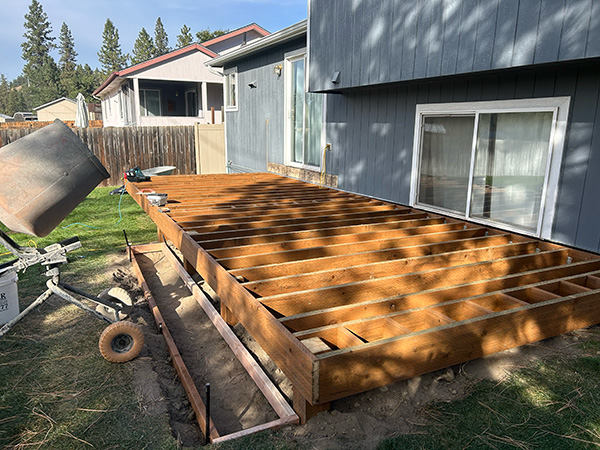
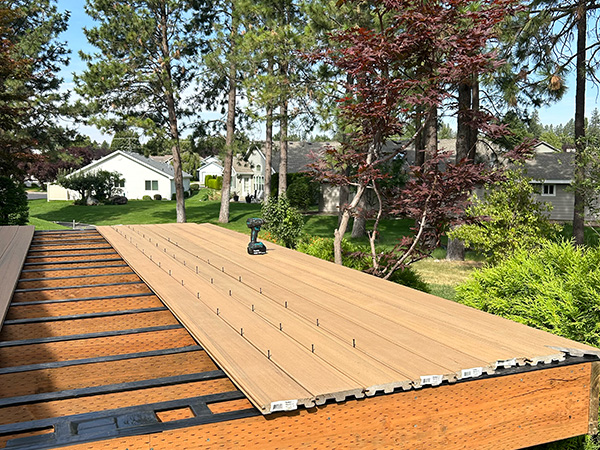
Considerations for Building a Deck Directly on the Ground
Check Local Building Codes
Before starting your ground-level deck project, check your local building codes to understand the requirements. In Spokane, a permit is not required for decks smaller than 200 square feet, but it’s always good to confirm with the local building department. If you’re unsure about the permit process, check out our blog post, “Do I Need a Permit to Build a Deck?”.
Use Proper Materials for Ground-Level Decks
Using the right materials is crucial for a ground-level deck. You want materials that resist moisture and pests, ensuring the deck lasts longer despite close contact with the ground.
a) Pressure-Treated Lumber
Pressure-treated lumber is ideal for ground-level decks because it’s treated to resist rot, decay, and insects. It’s an excellent choice for framing and structure. For more details on why pressure-treated wood is a good option, check out our blog post, “Why Use Pressure Treated Lumber & Its Benefits.”
b) Composite Decking
Composite decking is also a great choice for ground-level decks. It doesn’t rot, warp, or require as much maintenance as wood. Composite materials offer durability, a variety of colors, and resistance to the elements, making them perfect for ground-level decks.
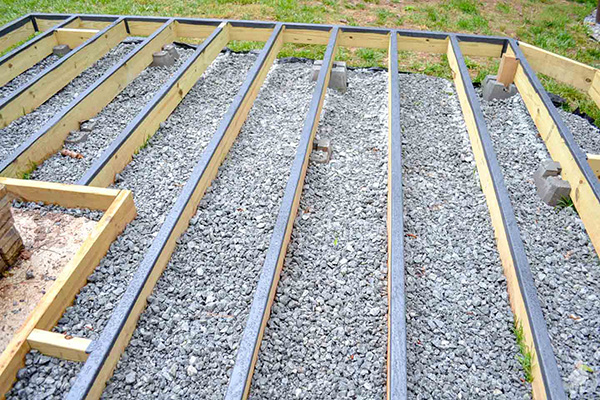
Preparing the Site for a Ground-Level Deck
Proper ground preparation ensures that your deck remains stable and resists moisture over time. Here’s what you need to do:
Ground Preparation
- Clear the Area: Remove any rocks, roots, or debris from the building site.
- Level the Ground: Use a longboard and level to ensure the ground is even. Compact the soil using a tamper to create a stable base.
- Add a Gravel Base: If you’re not using concrete blocks, add a gravel base to help with drainage and stability.
Installing Concrete Blocks as Footings
For ground-level decks, we recommend placing the deck on concrete blocks rather than directly on the soil. Concrete blocks provide more surface area, preventing the deck from sinking over time.
How to Install Concrete Blocks for a Ground-Level Deck
- Dig the Blocks In: Dig the blocks slightly into the ground to achieve the desired deck height.
- Positioning: Place the blocks under the rim boards to support the deck evenly.
- No Frost Line: Unlike elevated decks, the concrete blocks for ground-level decks do not need to be below the frost line. They simply need to support the deck’s load and ensure it stays level.
Building the Ground-Level Deck Frame
Building the frame involves setting up the rim boards and adding joists.
Framing the Deck
- Rim Boards: Set the rim boards on the concrete blocks. Ensure they’re level and secure.
- Joists: Attach the joists to the rim boards using galvanized nails, making sure they are spaced according to the deck’s requirements.
- Support: Since there are no beams for a ground-level deck, place additional concrete blocks under the rim boards for extra support.
Adding Deck Boards
Once the frame is secure, it’s time to add the deck boards.
Installing Deck Boards
- Use composite or wood deck boards, screwing them down securely.
- Ensure a small gap (typically 1/8 to 1/4 inch) between the boards to allow for expansion, drainage, and air circulation.
- Make sure the deck boards are level as you install them.
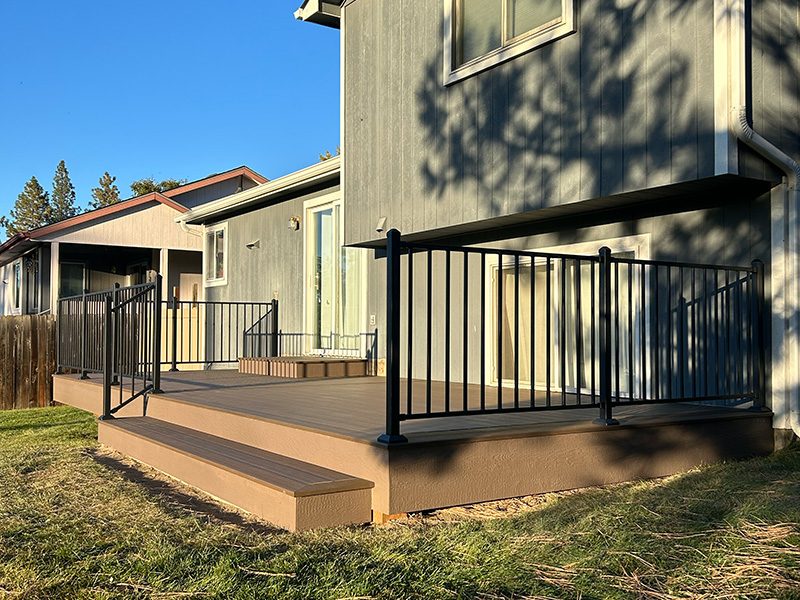
Finishing Touches for Your Ground-Level Deck
- Check for Stability: Walk across the deck to ensure it feels stable and solid.
- Apply a Protective Coating: If you used wood, apply a sealant to protect it from moisture.
- Inspect Regularly: Regularly inspect your ground-level deck for any signs of rot or settling, and make repairs as needed.
Ready to Upgrade Your Outdoor Space?
At Pacific Northwest Decks, we’re here to help you build a ground-level deck that fits your vision and lifestyle. Whether you need guidance in planning or want professional installation, we’ve got you covered. Contact us today to discuss your custom ground-level deck project or visit our Custom Decks Service page to learn more about our offerings.
FAQs
1. Can I build a deck directly on the ground?
Yes, you can build a deck directly on the ground. It’s often called a “floating deck.” However, it’s important to use moisture-resistant materials like pressure-treated lumber or composite decking to ensure the deck’s longevity.
2. Do I need a permit for a ground-level deck?
In Spokane, a permit is required if the deck exceeds 200 square feet. For more details, read our blog post on whether you need a permit to build a deck.
3. Why use concrete blocks instead of setting the deck on the ground?
Concrete blocks provide a stable base and prevent the deck from sinking. They also promote air circulation, reducing moisture build-up that could lead to rot.
4. What is the best material for ground-level decks?
Pressure-treated lumber and composite decking are ideal. Both resist moisture and rot, making them perfect for ground contact.
5. How do I maintain a ground-level deck?
Clean it regularly, check for moisture damage, and apply sealant if it’s made of wood. Ensure proper drainage to prevent water pooling around the deck.
In Spokane, a permit is required if the deck exceeds 200 square feet. For more details, read our blog post on whether you need a permit to build a deck.
Concrete blocks provide a stable base and prevent the deck from sinking. They also promote air circulation, reducing moisture build-up that could lead to rot.

